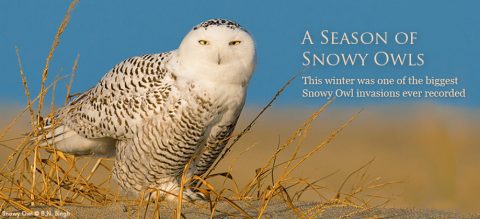Book Review: The Devil’s Cormorant, by Rich King
Review by Stephen J. Bodio
From the Spring 2014 issue of Living Bird magazine.
April 15, 2014
(University of New Hampshire Press)
Richard King’s The Devil’s Cormorant is a brilliant book. It is scientifically well-informed, serious, funny, and full of good stories; with its kaleidoscopic view of the cormorant, I might call it, tongue not entirely in cheek, a post-modern ornithology, showing how cormorants “signify” so many different things to so many different people.
King opens in Gifu, Japan, with traditional cormorant fishers, long subjects of poetry and art, and a quote. “The cormorant is the bridge between God and man.” Japanese fishing cormorants are as elegant in their peculiar way as trained falcons. “From a perch in a small tree that extends over a pond, a single cormorant presides like a dark prince.” King is frankly awed by the ceremony, called Ukai: “Yamashita wears the usho uniform. He looks like a sorcerer…while tending the fire, he manages a flock of 12 cormorants swimming in the river. He holds their leashes…in one palm, while with his other hand he adjusts each string—as the birds dive, fish, and return to the surface with their gullets full.” His whole Japanese essay is a remarkable piece of travel and nature writing, neatly balancing the poetic loveliness of traditional Japan and the necessary and sometimes hilarious weirdness of its preservation.
And then he takes you to Henderson Harbor on Lake Ontario, and a new protagonist: “We went out and killed about 20,000 cormorants…the tree-huggers and bunny-huggers didn’t want you to do anything as far as birds were concerned, even though they were destroying a way of life and a fishery and affecting millions and millions, in a fishery that was dying because of the birds. So, we…took the law into our own hands.” Apart from the shock, the genius of King’s book is that he presents Captain Ron Ditch nearly as sympathetically as he does Mr. Yamashita.
Humans’ attitudes toward cormorants have swung between these two extremes as long as humans and cormorants have eaten fish. After presenting the interesting fact that in 1974 there were 22 cormorant nests near Henderson Harbor, increasing and culminating in approximately 25,000 birds in 1996, he documents the control efforts that restored enough “balance” that, 10 years later, Captain Ditch felt justified. But note well a motif that will recur in King’s conclusion: there is nothing natural about Lake Ontario; its fish populations, even species, are human constructs.
King then takes us on a world and historical tour of cormorants, visiting the Aran Isles, the Galapagos, South Georgia Island, the Bering Sea, literature, and the fabulous natural history museum at Tring, England: still the most remarkable collection of bird specimens since it was Lord Rothschild’s pride. In literature, he slyly notes that King James’s trained cormorants (he was also a falconer) might well have caused his political opponent, the Puritan poet Milton, to see the Devil as a cormorant who “sat devising death to them that lived.”
At Tring, he searches for rare and extinct cormorants among the dry skins, hustled about by an imperious curator who disses taxonomic revisions. “We have never tried to be up to date with the latest taxonomic changes,” he hisses, as he makes excuses for not finding a bird that, though uncommon, I had no trouble seeing twice on the dammed River Euphrates in Turkey.
Eventually, after visiting catfish farms (which are predator magnets), the guano islands of Peru (where cormorants are not doing well, perhaps because their food stocks are depleted by industrial fishing), and the rehabbers of rare cormorants in Cape Town, South Africa, King returns to Lake Ontario. One of the lessons he has learned is as properly post-modern as my slightly tongue-in-cheek read of this fine book: “Cormorant taxonomy, like our assessment of almost all life on earth, remains fluid.”
But his last, most important lesson is real, about the nature of the crisis temporarily averted there. Remember that remark about how natural Lake Ontario is? “Because of how and where they fish cormorants are scapegoats for much larger, more difficult environmental concerns… if there are not wild fish in clean water and safe habitat, cormorants will not be there.” The first scientist to study cormorants, Harrison Lewis, in 1929, registered hope: “That bird, though unfortunate in some respects, is by no means as unpleasant as it has often been painted, but actually a reputable avian citizen, not without intelligence, amiability, and interest.”

All About Birds
is a free resource
Available for everyone,
funded by donors like you
American Kestrel by Blair Dudeck / Macaulay Library



